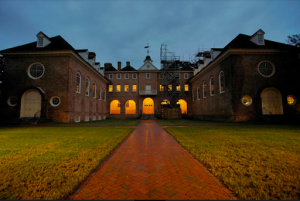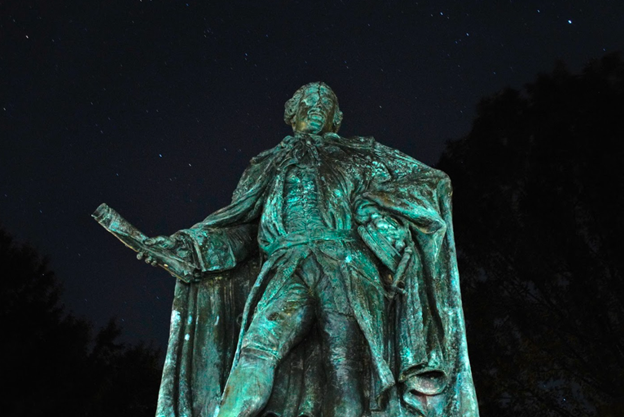It’s hard to believe that spooky season is already upon us. While traditional Halloween activities like Busch Gardens’ Howl-O-Scream and costume parties are not possible due to COVID-19, ghost stories are still an option. The College of William and Mary, according to campus lore, is home to many ghosts — some even consider the College one of the most haunted schools in the nation.
Of all of the College’s buildings, the Sir Christopher Wren Building is perhaps most consistently cited as haunted — which makes sense given its age and history. Not only is the Wren Building the College’s oldest building, but it’s also the oldest surviving college building in the United States. Many have traced the building’s haunting all the way back to the American Revolution when it was converted into a hospital for wounded French soldiers. Later, during the Civil War, it would again be converted into a makeshift hospital. As is the case during times of war, many soldiers who came to the Wren Building for treatment never made it out, having died of painful wounds or infections. Some claim the ghosts of these men still roam the building, particularly at night. Spooky figures, some in uniform, have been seen wandering the corridors. Those who report seeing these spectres say the ghostly figures vanish without a trace, before any identifying information can be gathered. Others have heard mysterious footsteps when no one else is around. To add a second layer of spookiness, there may be another source of haunting — in the crypts below the chapel, where many notable Virginians, including Peyton Randolph and Lord Botetourt, were buried. Perhaps the spirits of these early colonists are no longer at rest, having been awakened by fraternity pledges who supposedly used the underground steam tunnels decades ago to access the crypts and stole bones as part of an initiation rite. Some have theorized that the often-heard mysterious footsteps could be those of Sir Christopher Wren himself, the building’s namesake, walking around and admiring the restoration of his legacy.
The most famous campus ghost story may be the one featuring St. George Tucker Hall’s third floor. Supposedly, a ghost will approach a student studying alone, but only if the student is pulling an all-nighter studying for an exam. The ghost is said to approach the student and, like a good friend, kindly inquire how the studying is going. For those who (in true TWAMP fashion) complain about how terribly the studying is going, how much they have left to do, how they’re probably going to fail, etc., the ghost is compassionate and tries to console the student, sometimes recommending the student quit studying for the night and go to bed. Those who reply that the studying is going well and that they feel confident about their progress report being accosted by the ghost, who, in a jealous rage, moves their books and papers around, makes annoying noises and disrupts all attempts at studying, in effect forcing them to leave.
Hunt Hall, now a freshman dorm, was also once a hospital; like many buildings that were former hospitals, Hunt has ghost lore associated with it. Some students claim they have seen the ghost of a female nurse in uniform wandering the halls at night, while others have seen an odd shadow in the room. Accounts of moving furniture as well as inexplicable creaking at night further add to the lore of the haunting of Hunt Hall.

Phi Beta Kappa Memorial Hall is said to be home to the ghost of a former student of the College who was supposed to play the lead role in a theatre production, but died tragically in a car accident before the play’s opening night. According to legend, an understudy practicing one night claims to have seen a dress walking around without anyone wearing it. Some students, while practicing their lines or playing the piano, have heard unidentifiable noises, and others report seeing the figure of a woman wearing a dress. Some have only heard her voice.

Colonial Williamsburg also has its fair share of hauntings, most notably the Peyton Randolph House on Nicholson Street, which is considered by some to be one of the most haunted houses in America, due to the number of reported paranormal encounters as well as the house’s history of tragedy. The first of many deaths that occurred in the house was that of John Randolph, the original owner of the house, who is said to have died a painful death of stomach cancer after having been “treated” for months with painful bleeding and other archaic 18th century attempts at medical treatment. The next owner of the house was his son, Peyton Randolph, one of the most influential men in Virginia at the time, having served as the President of the First Continental Congress and the Speaker of the House of Burgesses. The curse could explain the string of often violent deaths that later occurred in the house. A smallpox epidemic claimed the lives of several residents in the mid-1700s. Some suspect these victims haunt the house. The Marquis de Lafayette, a French general during the American Revolution, visited the Peyton Randolph House in 1824. Lafayette claimed a cold hand gripped his shoulder in the dead of night; he also said he heard mysterious voices. Other visitors to the house who stayed the night corroborated his claims. Some suspect that the spirits of Union and Confederate soldiers injured during the Battle of Williamsburg who were treated – and later died — in the Randolph House when it was converted into a makeshift hospital in 1862 still roam the halls in permanent agony. In the late 1800s, a young boy is said to have died after falling out of one of the property’s trees, and a young girl also died after falling out of a second-story window of the house, leading some to suggest malevolent spirits are at work in the home. Two men staying at the house also supposedly killed each other after an argument quickly escalated. Many visitors to the house claim to have heard moans, knocking sounds, giggling children and moving furniture, and supposedly, a security guard once even claimed to have been held down by a paranormal force. Others have claimed to see strange orbs. Given its violent and tragic past, it certainly seems to deserve its title as one of the most haunted buildings in America.
Some say the George Wythe House is haunted by George Wythe himself, after his vicious murder at the hands of his grandnephew. However, legend also claims there is a second haunting by a woman named Lady Ann Skipwith, who visited George Wythe with her husband. There are two possible theories regarding her death. The more historically accepted — and less dramatic — story is that she died of a miscarriage, yet some claim she actually died by suicide after discovering her husband was having an affair with her younger sister. This theory is supported by the fact that her husband did, in fact, marry her younger sister less than a year after her death. Those who claim to have seen her ghost say that she wears the ball gown she supposedly wore when she discovered her husband’s affair, as well as one red shoe and lavender perfume.
Hopefully this can serve as a starting guide for those curious about possible haunted sites, but it is by no means an exhaustive list of the College’s and the City’s ghosts. The next time you see someone not wearing a mask and forgetting to social distance, it may not be an annoying tourist or a forgetful student — it could be one of Williamsburg’s renowned spirits making its way to the millinery shop to inquire about the latest mask trend.





































[…] The student paper, The Flat Hat reports: […]